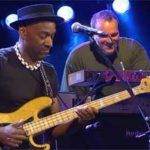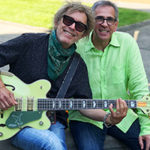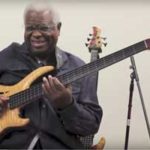… and what happened next!
By Gary Graff, FBPO Contributing Editor
November 19, 2014
When our first feature on bands that changed bass players received such an overwhelming response from our followers, we decided to do a follow-up. So, here’s Part II of our survey of famous bass replacements over the years — significant changes and their results…
The Kinks
Pete Quaife/Jim Rodford
The Drama: While most of the extra-musical attention for the Kinks centers on battling brothers Ray and Dave Davies, the group was served by a trio of bassists during its 34 active years. The late Pete Quaife was on board at the beginning, leaving in 1969 after forming another band, Maple Oak. John Dalton, who had filled in briefly for Quaife during the 60s, came on board and stayed until sessions for 1977’s Sleepwalker. Andy Pyle finished the album and played on the tour to support it, with former Argent bassist Jim Rodford coming on board in 1978 and staying until the Kinks ground to a halt in 1997.
The Upshot: All three of the Kinks’ primary bassists played on their share of triumphs — Quaife during the early years of hit singles, Dalton during the conceptual ‘70s and Rodford for more hits such as “A Rock ‘N’ Roll Fantasy” and “Come Dancing.” A rare occurrence of win-win-win for all concerned.
King Crimson
Greg Lake/Tony Levin
The Drama: Can’t tell your players without your scorecard here. Robert Fripp has kept fans and bandmates off guard and on edge throughout King Crimson’s myriad transitions, and his lineup of bassists is an all-star crew that’s included Greg Lake(1968-70), Gordon Haskell (1970), Boz Burrell (1971-72), John Wetton (1972-74), Tony Levin (1981 off and on to the present) and occasionally Trey Gunn from 1994-2003.
The Upshot: Everyone of these guys is killer, so it’s not like Crimson suffered for any of their departures or arrivals. Different periods of Crimson’s career appeal to different fans, but most have bought into the idea that Fripp doesn’t owe anybody anything and usually comes up with something that’s intriguing – and ultimately doesn’t really care what we think about it.
Chicago
Peter Cetera/Jason Scheff
The Drama: Besides playing bass, Peter Cetera was one of Chicago’s key songwriters and arguably its most recognizable vocalist — never more so than during its soft rock hit run of the early ‘80s (“Hard to Say I’m Sorry,” “Love Me Tomorrow,” “Hard Habit to Break”). He came to loggerheads with his bandmates over a desire to tour less and to make more solo albums, leading to his departure in July of 1985 and the arrival of Jason Scheff, son of Jerry Scheff (Elvis Presley, the Doors and more).
The Upshot: With a similar vocal timbre and the bass chops you’d expect given his lineage, Scheff has been a fine replacement for Cetera. Though Chicago had started out with a pair of platinum albums (Chicago 18 and Chicago 19 in 1986 and 1988, respectively) the group has not exactly torn up the charts since.
The Stooges
Ron Asheton/Mike Watt
The Drama: Smooth sailing has never been the Stooges’ way. The late Dave Alexander joined Scott “Rock Action” Asheton in propelling the group through its first two albums, but when the Stooges regrouped under the auspices of Iggy Pop and James Williamson during the early ‘70s, guitarist Ron Asheton was moved to bass for the landmark Raw Power album. When the group resumed in 1993, however, Asheton was back on guitar and Mike Watt (The Minutemen, fIRHOSE, etc.) was on bass, where he remains to this day.
The Upshot: Three primary bassists with three different sounds and approaches, all of which have proven to be right for the time they were in the band. Some viewed Asheton’s move to bass as a “demotion” at the time, but his style as crucial an ingredient for Raw Power as anything else his bandmates created. And Watt has successfully melded his own avant/virtuostic chops with Alexander’s style of “garagey” punk on later albums such as The Weirdness and Ready To Die.
Weather Report
Miroslav Vitous/Jaco Pastorius
The Drama: Like many jazz ensembles, Weather Report was a revolving door led by a couple of stalwart co-founders (Joe Zawinul and Wayne Shorter) and an all-star array of other members, especially in the bass chair. Jaco Pastorius, from 1976-81, was part of Weather Report’s greatest commercial successes, but the group also housed tenures by co-founder Miroslav Vitous, Alphonso Johnson and Victor Bailey.
The Upshot: Weather Report went through a variety of sounds and approaches during its 16 years, all of them of merit. Pastorius’ Heavy Weather and its hit “Birdland” are, of course, most people’s first stop, but you’ll find something interesting at virtually every point of the group’s discography.
Lynyrd Skynyrd
Leon Wilkeson/Ean Evans
The Drama: A case where one guy, Leon Wilkeson, was “The Man” and several have followed, mostly successfully, in his footsteps. Wilkeson was on board from the beginning, playing with Skynyrd from 1972 through its hiatus following the tragic 1977 plane crash, and then from the 1987 reunion through his death in July of 2001 from natural causes. (He was also part of the Rossington Collins Band and the Allen Collins Band during Skynyrd’s decade apart.) He’s been followed by Ean Evans (2001-09) and Robert Kearns (2009-12), with former Black Crowes bassist Johnny Colt now filling his spot.
The Upshot: And it is Wilkeson’s spot, without a doubt. All of his successors have been fine players and, to this point, have played on one studio album each, but Wilkeson made the mold, and every time they play “Free Bird,” “Sweet Home Alabama” or any of the other Southern Rock classics, they’re paying homage to him.
Blondie
Nigel Harrison/Leigh Foxx
The Drama: A checkered history when it comes to bassists, to be sure. Fred Smith was first until he left to replace Richard Hell in Television in 1975. Gary Valentine played on the first album, while Nigel Harrison played the rest of the way during Blondie’s first incarnation that ended in 1982. Leigh Foxx has held down the bottom since Blondie reactivated in 1997, though Harrison was part of a lawsuit trying to prevent his former bandmates from using the Blondie name.
The Upshot: Harrison’s tenure during Blondie’s hit- and reputation-making days makes him the definitive bassist for the band, though he maintains a nasty chip on his shoulder about it continuing without him, which was aired during the group’s 2006 induction into the Rock and Roll Hall of Fame.
Elvis Costello’s Attractions/Imposters
Bruce Thomas/Davey Faragher
The Drama: Forming the Attractions in 1978, Costello picked Bruce Thomas, formerly of the Sutherland Brothers and Quiver, whose busy, melodic, quasi-McCartney-esque playing brought plenty of sonic dynamics to Costello’s key releases. The two ultimately had a falling out – Thomas’ explicit memoir, The Big Wheel, had something to do with that – that led to the end of the Attractions, in name, in 1996, and Costello brought in California-born Davey Faragher, a member of Cracker and a busy session player, to work with him, keyboardist Steve Nieve and drummer Pete Thomas as the Imposters during the early 2000s.
The Upshot: Plenty of bandleaders would give an appendage to have the good fortune Costello has had with his bass players (including collaborations with Paul McCartney and Jerry Scheff) over the years. Bruce Thomas was certainly a one-of-a-kind musician who elevated Costello’s songs, but Faragher is certainly his equal and manages to capture both the original Attractions’ flavor and add his own stamp to Costello’s more recent projects.
The Pretenders
Pete Farndon/Malcolm Foster
The Drama: Pete Farndon was the group’s original bassist – as well as leader Chrissie Hynde’s boyfriend – and was on board for its first two albums until being fired in June of 1982 for drug use and eroding relationships with the rest of the band; he died of an overdose nine months later. After a couple of brief fill-ins – Tony Butler and Andrew Bodnar – Malcolm Foster joined for the hit Learning to Crawl album in 1984, only to be replaced by T.M. Stevens during the making of its follow-up, 1986’s Get Close. Foster wound up spelling Stevens for shows during 1986-87, while a number of other players – including the Smiths’ Andy Rourke – did time with Hynde and company after the Pretenders returned from a three-year hiatus in 1990.
The Upshot: Farndon was part of the blueprint, while Foster was the right ingredient in his stead to help bring the Pretenders back to form during the mid-‘80s. The group is currently back on hiatus while Hynde works as a solo artist.
Guns N’ Roses
Duff McKagan/Tommy Stinson
The Drama: For all the tumult that’s part and parcel in this band, GN’R has only had two bassists (not counting short-timer Ole Beich in 1985). Duff McKagan held down the spot from 1985 until 1997, though he’s made a few cameo appearances during the past few years, including subbing for his replacement, Replacements’ bassist Tommy Stinson, during shows in South America earlier this year.
The Upshot: A bit of an unfair comparison. McKagan was part of GNR’s meteoric rise and helped establish the group’s sonic template; among his trademark moments is the melodic bass line during the introduction of “Sweet Child O’ Mine.” Stinson has had only one album, 2008’s Chinese Democracy, to make his mark, though he’s been part of GN’R’s touring apparatus since 1998 and enjoys a graceful, friendly relationship with his predecessor that’s made McKagan’s occasional drop-ins welcome and drama-free.






